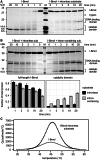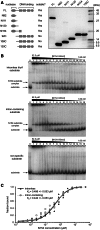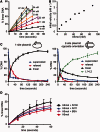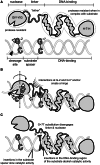The monomeric GIY-YIG homing endonuclease I-BmoI uses a molecular anchor and a flexible tether to sequentially nick DNA
- PMID: 23558745
- PMCID: PMC3664794
- DOI: 10.1093/nar/gkt186
The monomeric GIY-YIG homing endonuclease I-BmoI uses a molecular anchor and a flexible tether to sequentially nick DNA
Abstract
The GIY-YIG nuclease domain is found within protein scaffolds that participate in diverse cellular pathways and contains a single active site that hydrolyzes DNA by a one-metal ion mechanism. GIY-YIG homing endonucleases (GIY-HEs) are two-domain proteins with N-terminal GIY-YIG nuclease domains connected to C-terminal DNA-binding and they are thought to function as monomers. Using I-BmoI as a model GIY-HE, we test mechanisms by which the single active site is used to generate a double-strand break. We show that I-BmoI is partially disordered in the absence of substrate, and that the GIY-YIG domain alone has weak affinity for DNA. Significantly, we show that I-BmoI functions as a monomer at all steps of the reaction pathway and does not transiently dimerize or use sequential transesterification reactions to cleave substrate. Our results are consistent with the I-BmoI DNA-binding domain acting as a molecular anchor to tether the GIY-YIG domain to substrate, permitting rotation of the GIY-YIG domain to sequentially nick each DNA strand. These data highlight the mechanistic differences between monomeric GIY-HEs and dimeric or tetrameric GIY-YIG restriction enzymes, and they have implications for the use of the GIY-YIG domain in genome-editing applications.
Figures










Similar articles
-
Applications of Alternative Nucleases in the Age of CRISPR/Cas9.Int J Mol Sci. 2017 Nov 29;18(12):2565. doi: 10.3390/ijms18122565. Int J Mol Sci. 2017. PMID: 29186020 Free PMC article. Review.
-
Divalent metal ion differentially regulates the sequential nicking reactions of the GIY-YIG homing endonuclease I-BmoI.PLoS One. 2011;6(8):e23804. doi: 10.1371/journal.pone.0023804. Epub 2011 Aug 22. PLoS One. 2011. PMID: 21887323 Free PMC article.
-
Strand-specific contacts and divalent metal ion regulate double-strand break formation by the GIY-YIG homing endonuclease I-BmoI.J Mol Biol. 2007 Nov 23;374(2):306-21. doi: 10.1016/j.jmb.2007.09.027. Epub 2007 Sep 16. J Mol Biol. 2007. PMID: 17936302
-
Distance determination by GIY-YIG intron endonucleases: discrimination between repression and cleavage functions.Nucleic Acids Res. 2006 Mar 31;34(6):1755-64. doi: 10.1093/nar/gkl079. Print 2006. Nucleic Acids Res. 2006. PMID: 16582101 Free PMC article.
-
Homing endonuclease structure and function.Q Rev Biophys. 2005 Feb;38(1):49-95. doi: 10.1017/S0033583505004063. Epub 2005 Dec 9. Q Rev Biophys. 2005. PMID: 16336743 Review.
Cited by
-
Genes and junk in plant mitochondria-repair mechanisms and selection.Genome Biol Evol. 2014 Jun 5;6(6):1448-53. doi: 10.1093/gbe/evu115. Genome Biol Evol. 2014. PMID: 24904012 Free PMC article.
-
Biochemical and mechanistic analysis of the cleavage of branched DNA by human ANKLE1.Nucleic Acids Res. 2023 Jun 23;51(11):5743-5754. doi: 10.1093/nar/gkad416. Nucleic Acids Res. 2023. PMID: 37216589 Free PMC article.
-
Function of the N-terminal segment of the RecA-dependent nuclease Ref.Nucleic Acids Res. 2015 Feb 18;43(3):1795-803. doi: 10.1093/nar/gku1330. Epub 2015 Jan 23. Nucleic Acids Res. 2015. PMID: 25618854 Free PMC article.
-
Mitochondrial DNA Repair in an Arabidopsis thaliana Uracil N-Glycosylase Mutant.Plants (Basel). 2020 Feb 18;9(2):261. doi: 10.3390/plants9020261. Plants (Basel). 2020. PMID: 32085412 Free PMC article.
-
Applications of Alternative Nucleases in the Age of CRISPR/Cas9.Int J Mol Sci. 2017 Nov 29;18(12):2565. doi: 10.3390/ijms18122565. Int J Mol Sci. 2017. PMID: 29186020 Free PMC article. Review.
References
Publication types
MeSH terms
Substances
LinkOut - more resources
Full Text Sources
Other Literature Sources
Molecular Biology Databases

